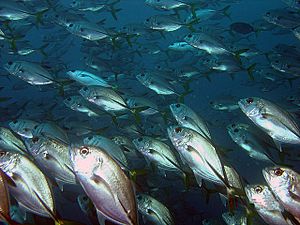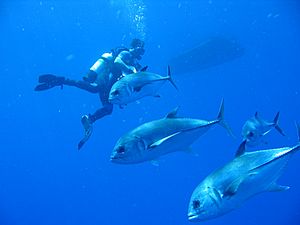Horse-eye jack facts for kids
Quick facts for kids Horse-eye jack |
|
|---|---|
 |
|
| Conservation status | |
| Scientific classification | |
| Synonyms | |
|
The horse-eye jack (Caranx latus), also called the big-eye jack, is a type of game fish and a minor commercial fish. It belongs to the family called Carangidae, which includes many jacks and trevallies. This fish looks a bit like the crevalle jack, but its head is not as flat. Horse-eye jacks are known to eat smaller fish and many invertebrates, like shrimp and crab.
Contents
About the Horse-Eye Jack's Name
The horse-eye jack was first described by a scientist in 1831. His name was Louis Agassiz, and he was a Swiss naturalist. He found a specimen of the fish in Brazil. Agassiz named the fish Caranx latus. The word latus comes from Latin and means 'broad'. This might refer to the fish's wide body.
The horse-eye jack is part of the Caranx group, which includes many types of jacks and trevallies. This group is part of the larger Carangidae family. People commonly call this fish the horse-eye jack because of its large eyes. Other names for it are big-eye jack or false jack.
What Horse-Eye Jacks Look Like

The horse-eye jack is a large fish. It can grow up to 101 cm long and weigh as much as 13.4 kg. However, most of them are smaller, usually less than 60 cm long.
This fish has a body shape similar to other large jacks. Its body is somewhat flat from side to side and deep. The front part of its body, near the head, is more curved. Its eyes are very big compared to the rest of its head.
The horse-eye jack has two dorsal fins on its back. The first one has eight stiff spines. The second has one spine and 19 to 22 soft rays. Its anal fin on its belly has two separate spines in the front, followed by one spine and 16 to 18 soft rays. The fins on its sides, called pectoral fins, are long and curved.
The fish has a special line along its side called the lateral line. This line helps it sense movements in the water. The back part of this line has 32 to 39 strong, bony plates called scutes. The upper jaw has strong outer canine teeth and smaller teeth inside. The lower jaw has a single row of teeth.
Adult horse-eye jacks are usually dark blue or silvery-blue on top. Their belly is silvery-white or golden. Sometimes, the tip of their soft dorsal fin and the scutes can be dark blue or black. Their caudal fin (tail fin) is yellow to dusky. Unlike some other jacks, they don't have a dark spot at the base of their pectoral fin. Young horse-eye jacks have about five dark stripes on their sides, which disappear as they get older.
Where Horse-Eye Jacks Live
Horse-eye jacks are commonly found in the warm, subtropical parts of the Atlantic Ocean. You can find them from Bermuda and the northern Gulf of Mexico all the way south to Rio de Janeiro in Brazil. In the eastern Atlantic, they live around St. Paul's Rocks and Ascension Island.
This fish is a pelagic fish, meaning it lives in the open ocean. They can be found near reefs and offshore oil rigs. Young horse-eye jacks often stay closer to shore on sandy or muddy bottoms. They can even go into brackish waters, like river mouths, but they mostly live in saltwater up to 140 meters deep.
Adult horse-eye jacks often swim together in a school. Sometimes, they school with other types of fish, like crevalle jacks. They might even swim in pairs with very different species, such as the Halichoeres radiatus, a type of wrasse.
Horse-Eye Jacks and Humans
Horse-eye jacks are usually shy around scuba divers. They will slowly swim away as divers get close. However, sometimes large schools of them will gather around divers, seemingly interested in the bubbles divers breathe out.
People enjoy catching horse-eye jacks for fun, making them a popular game fish. They are also caught for food by both commercial and recreational fishermen. The biggest horse-eye jack ever caught, according to the IGFA (International Game Fish Association), weighed 14.51 kg. It was caught in the Gulf of Mexico off Texas, USA.
These fish are also used as bait to catch bigger game fish. This includes fish like Atlantic Sailfish, Blue Marlin, Tarpon, and Snook.
It's important to know that horse-eye jacks can sometimes carry a natural toxin called ciguatera. This toxin can make people sick if they eat the fish. Because of this, it's advised to be careful if you plan to eat them.
See also
 In Spanish: Caranx latus para niños
In Spanish: Caranx latus para niños




